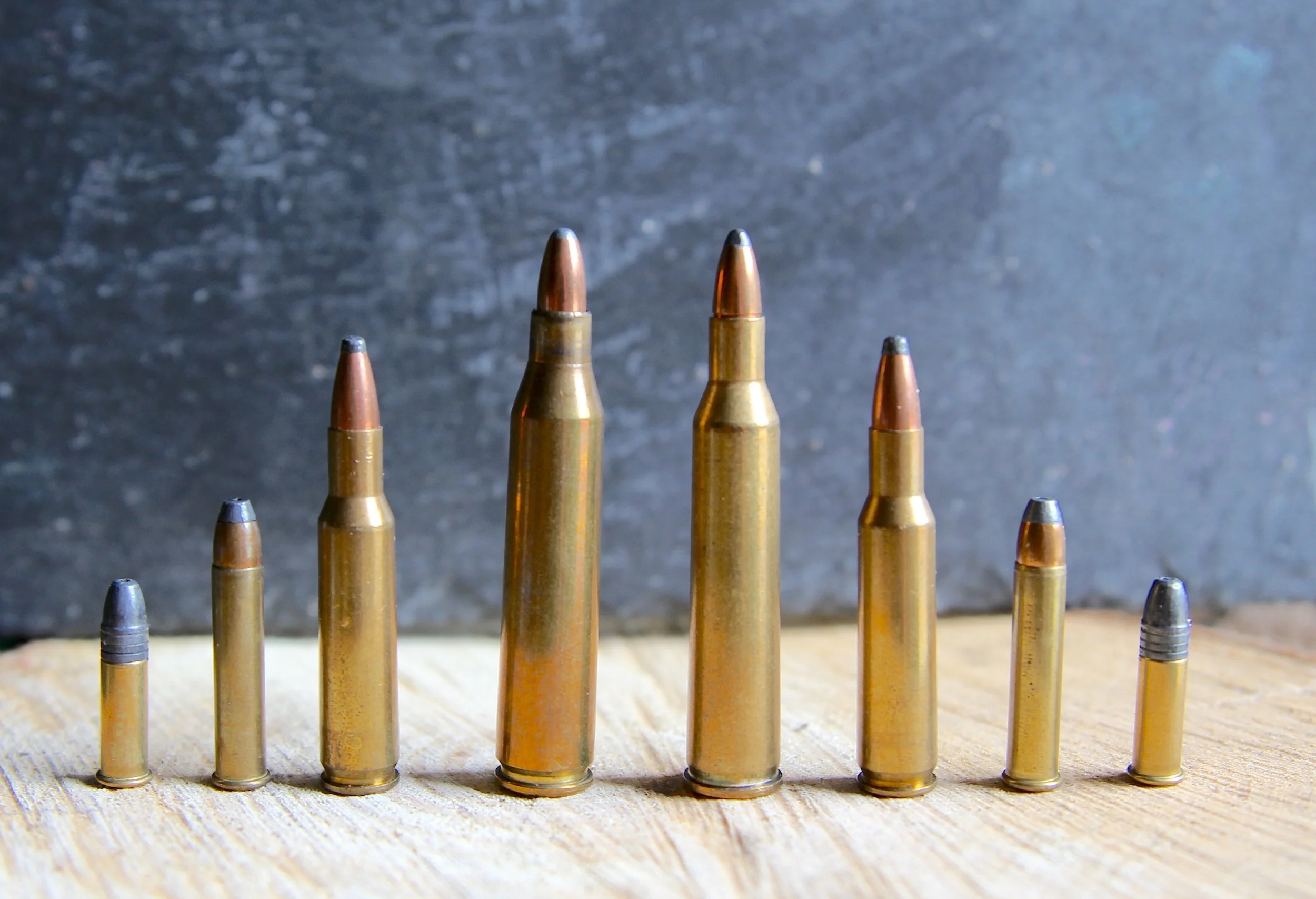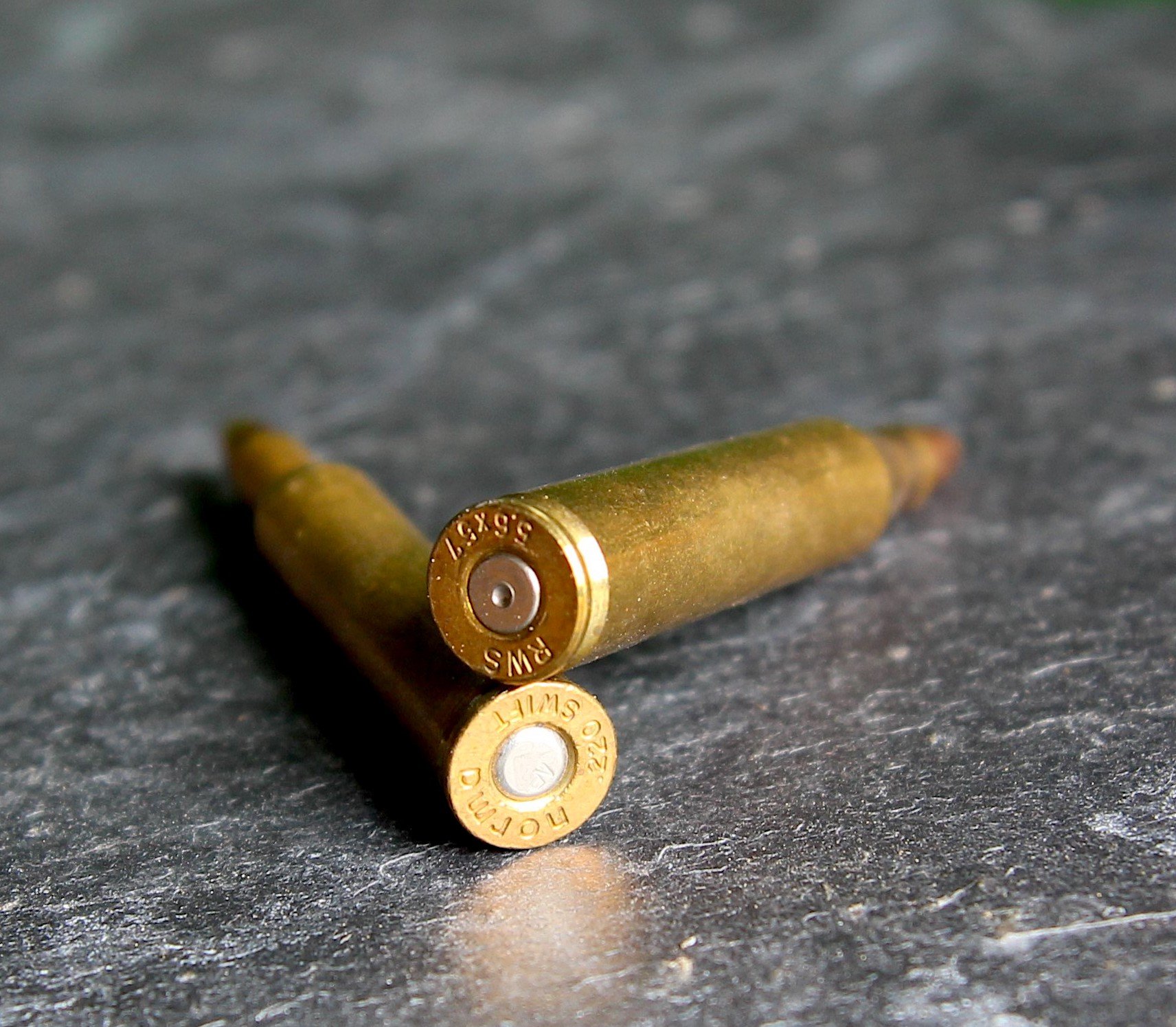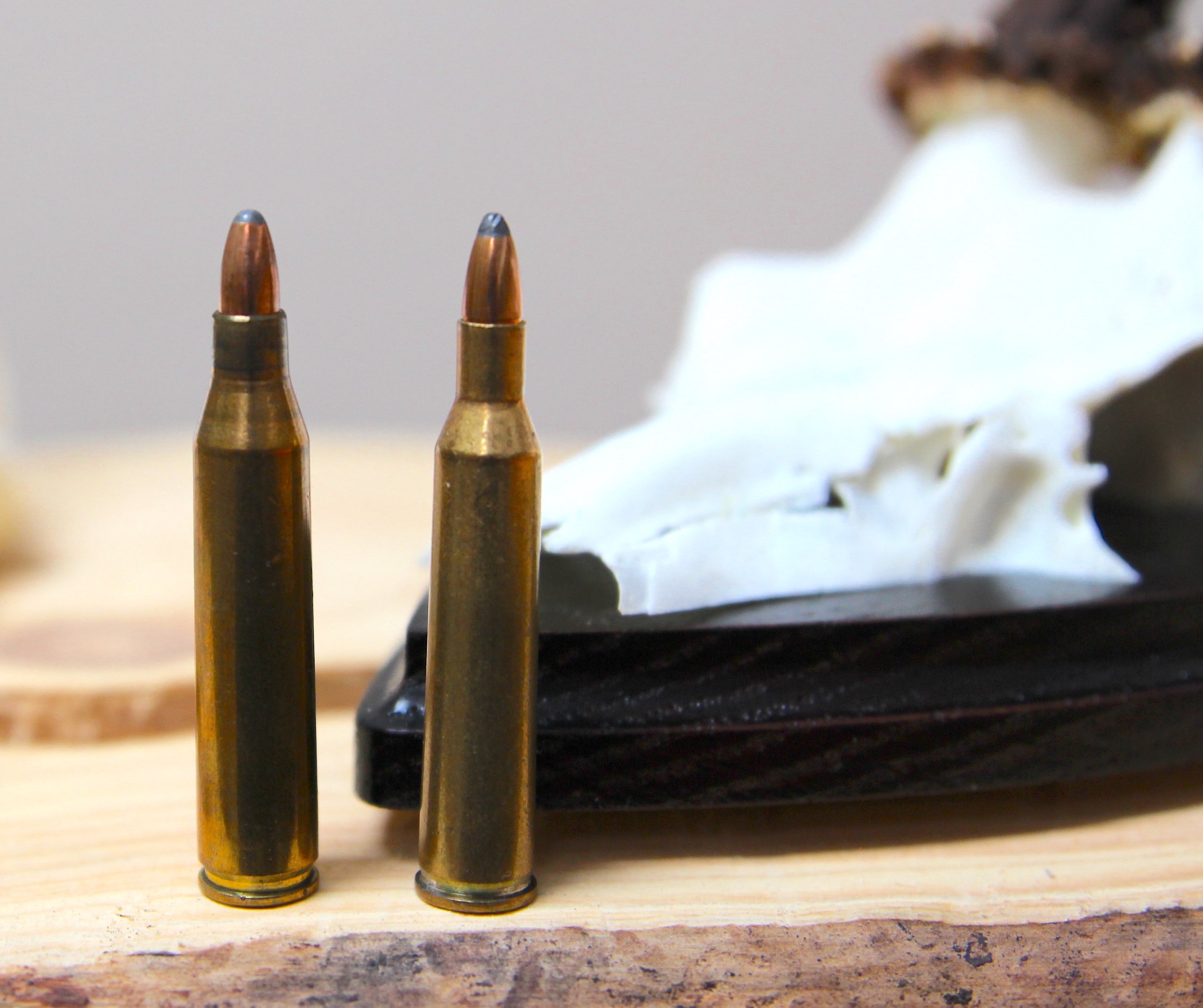Unknown 22 Cartridge Shoots Faster than 220 Swift
The .220 Swift is one hell of a cartridge, often said to be the fastest commercial cartridge on the market. But is that true? Perhaps not quite! The claim might be valid in the American market, but there’s a certain German cartridge that can shoot .224 bullets of any given weight up to 100 fps faster than the Swift. The cartridge I refer to has a metric designation, no surprise: the 5.6x57mm.
The 5.56x57 cartridge with a classic European chamois trophy. Those little mountain “goats” are a good match for this speedy little 22-caliber.
Looks ike an early satellite launch rocket, doesn’t it? But those pragmatic Germans skipped the rocket reference when naming this round. The 5.6mm (.224 inch) wide bullet sits atop a 57mm (2.232 inches) long case. The overall length of 2.717 inches indicates we’re dealing with a short action cartridge. Since the AR platform plays no role in Europe, the 5.6x57mm is almost exclusively a bolt action chambering.
A rimmed version exists for break-action guns, as is often the case with European cartridges, but I can’t remember the last time I saw an offering for a gun chambered in 5.6x57R (rimmed). The performance level of both variants is quite similar, so I won’t dive much deeper into the specifics of the rimmed sibling. As a side note, rimmed sister cartridges were usually loaded to slightly lower pressures to ensure safe use in less strong break actions.
This platform for an extraordinary fast .224 bullet is the brainchild of a famous German ammo developer and manufacturer. RWS (Rheinisch-Westfälische Sprengstofffabriken) designed several cartridges for various purposes, hunting being the primary focus. In 1964, they introduced this pill as an option for roe deer and chamois hunters seeking flat shooting characteristics in a low recoiling setup. And that’s where one huge difference lies when comparing it to the .220 Swift: it was not designed for flattening rodents or harvesting varmints but shooting hoofed critters. Albeit small, both mentioned species weigh more than most predators. This is the reason for its perceived lower speed: it usually shoots heavier bullets than the Swift, as those work better on larger game.
Up and down the 22-caliber ladder from L. to R. are 22 Long Rifle, 22 Winchester Magnum, 222 Remington, 5.56x57, 220 Swift. And then back down with the 222 Rem., 22 Win. Mag., and 22 LR.
A typical 5.6x57mm factory load, therefore, is slower than most.220 Swift loads. Would one load both cartridges with the same weight bullets? The bigger case of the German design (49.1 grains of water compared to 47 grains) allows for higher speed. Of course, actual capacity depends on the brass, but in general, the 5.6mm has a slight advantage here. Combined with a slightly higher maximum chamber pressure (63,818 psi for the RWS cartridge vs. 62,000 psi for the .220 Swift), the 5.6x57 has what it takes to surpass the .220 Swift.
The preferred bullet weights go hand in hand with fitting twist rates: the 5.6mm is usually launched from barrels boasting a 1 in 9.84-inch twist while a 1 in 14 or 1 in 16-inch rifling is common for .220 Swift rifles. Different purpose, different design, I guess. The lighter, faster bullets that work well on small critters perform better in the Swift, and heavier bullets are better stabilized in a 5.6x57mm. This should translate into a small advantage when extending the range of .224 bullets in shooting competitions (less drift, more retained energy, and more drop). But 22-calibers are rarely used for extreme-range work, so this is insignificant. With custom barrels and adjusted twist rates, the difference between both cartridges starts to blur.
As mentioned, the intended use of the 5.6mm from R.W.S. was roe deer and chamois hunting. The cartridge shined in this role, but today chamois can not be legally hunted with bullets smaller than 6.5mm in Germany and smaller than 6mm in Slovenia. In Austria, the cartridge is still legal for shots on chamois, as far as I know. But fewer places to use a gun usually mean a drop in sales figures, both for rifles and ammunition. And that, for sure, leads to fewer and fewer factory ammo options in the long run.
Headstamps tell the tale. Note the rimless style of the 5.56x57 and the semi-rimmed base of the 220 Swift.
5.6/.224 caliber cartridges are small but still enough to humanely kill even bigger game such as sika deer or even small red deer with heavy for caliber bullets and careful shot placement. Need proof? Here it is: when Ireland banned the sporting/hunting use of all calibers larger than 5.6mm for some decades, hunters largely depended on the R.W.S. pill. The background to the ban was the violent conflict between the I.R.A. and Great Britain in Northern Ireland. In lack of alternatives, countless deer met their end at the nose of a 74-grain cone-pointed bullet, which is the standard load for that cartridge. And what worked for Irish deer species should work for American deer. Today, the cone-pointed R.W.S. load is the only factory load. This is not a fragile varmint bullet. It’s designed for reliable expansion instead of explosive fragmentation.
With only this choice of loaded ammo, we’d better look at the reloading characteristics of this R.W.S. cartridge. Unfortunately, things don’t look much brighter here. The case wall is quite thick in the neck. Reportedly this was done to accommodate chamber adapters so .22 Magnum and .22 L.R. cartridges could be fired in 5.6x57 rifles for cheaper practice sessions. The thick neck wall poses issues when re-sizing the neck and seating bullets. Since I’ve never tried that myself, I can only offer second-hand information. In general, handloading for this cartridge is possible, but a bit of extra work. The single factory load plus tricky reloading have the 5.56x57 on the brink of extinction. Even in Europe, few people will recommend buying a gun in this chambering for those reasons.
The paucity of factory loads is a shame, in my opinion, as the 5.6x57 can be a fantastic cartridge for smaller deer, varmints at extended ranges, or even shooting competitions. It’s probably one of the best .224 platforms for hunting hoofed game when used heavily for caliber bullets with high sectional density. The low recoil is easy to control, making long series of shots very bearable. Young or small-framed shooters, or just anyone, will come to appreciate the ballistic performance without recoil punishment.
The little sika deer imported into Europe are another “just right” quarry for a hunter armed with the 5.56x57.
For a better understanding of the cartridge’s capabilities, let’s take a look at the energy levels and speed produced by the 74-grain con-pointed bullet when fired from a 24-inch barrel. The bullet exits the muzzle with 1040 m/s, which translates to 3,412 fps. Let that sink in: a .224 inch bullet that creeps up to the weight of .243 Winchester bullets traveling over 3,400 fps.
At this speed, the bullet of the 5.6mm cartridge hits with quite some authority. One thousand nine hundred fifteen ft-lbs of kinetic authority, to be precise. Consider recommendations of 2,000 ft-lbs, some say 1,500 ft-lbs of energy for the reliable killing of game as large as elk. That doesn’t mean I recommend using the cartridge on elk, but it puts the performance in perspective.
German foxes on the far sides of big, open fields are a fair contest for the 5.6x57.
To get back to my bold claim of outpacing the fastest cartridge ever built, I must admit it is somewhat an apples to oranges comparison. The common .220 Swift loads are faster than the 5.56x57 74-grain load because the 220 Swift bullets are usually 55-grains. But with identical bullets, the German cartridge has the potential to a head-to-head race. That might not be enough to justify a change in your gun safe, but the speed potential plus the possibility of using heavier bullets are intriguing.
Now let’s compare the .223 Remington as the standard in this class of cartridges. A 55-grain bullet should leave a 24-inch tube with something like 3,240 fps and knock on the door with 1,265 ft-lbs of kinetic energy. A 77-grain bullet travels at a speed of 2,750 fps for 1,301 ft-lbs of impact energy. Compare these numbers to the ballistics mentioned above, and hunters obsessed with the .223 Remington will probably find some respect for this German cartridge.
Since the eruption of long-range specific cartridges and AR-15 compatible cartridges, a few American designs for heavier .224 bullets emerged. The .22 Nosler, the .223 WSSM, and the .224 Valkyrie, to name a few. Those almost reach the velocity of the RWS cartridge and certainly offer enough for the American rifleman to stick with the wider selection of loads.
The 5.56x57 and 220 Swift look like brothers from the same mother, but each was created independently of the other.
The barrel burner reputation of the .220 Swift certainly applies to the RWS cartridge. But modern metallurgy and careful use certainly reduce the well-known disadvantages of these hot cartridges. You can get 1,000-plus rounds with top-end accuracy out of good barrels, often a lot more. After each range session, a short series of shots, time to cool down, and thorough cleaning go a long way towards extending barrel life.
Is there a place for this cartridge in the north American hunting landscape? Or worldwide? Maybe. Besides hunting coyotes, bobcats, wolves, pronghorn, and possibly deer on the North American continent, I can see this cartridge excel on smaller plains game species in the wide-open spaces of Southern Africa. A duiker 300 yards down a dry river bed? No problem. A warthog cruising in and out of cover in grasslands, leaving no time to laser range the exact distance? Sounds like a job for the 5.6x57mm. Cull hunts and meat hunts like those conducted in Namibia and South Africa come to mind, too. When used at the range, the RWS design with its massive case volume could be a great platform to launch the heaviest .224 inch bullets, like the 95 grain Sierra MatchKing Hollow Point Boat Tail bullets.
The North American pronghorn would seem a suitable candidate for application of a 5.56x57 rifle.
Even with heavy bullets, excellent accuracy and minimal meat loss, low recoil, and flat trajectory merge and form something quite useful for various applications.
The high cost of a box of the only factory load available combined with the difficulties in handloading sentence the 5.56x57 to life in the periphery. Most shooters won’t bother putting up with the drawbacks when other lightning-fast .224 cartridges exist. But in the right hands, probably of an aficionado of rare calibers, this little-known 5.56x57 can work wonders. In Europe, the used gun market regularly offers high-quality guns chambered in 5.6x57mm. For low costs, at that.
For now, the cartridge might only be of interest for gun nuts. And it might be destined to fade into the history. But suppose just one of the major ammunition manufacturers would start producing quality ammo at reasonable prices with a decent selection of bullets. In that case, I bet the cartridge has all that it takes to rise in popularity again.











